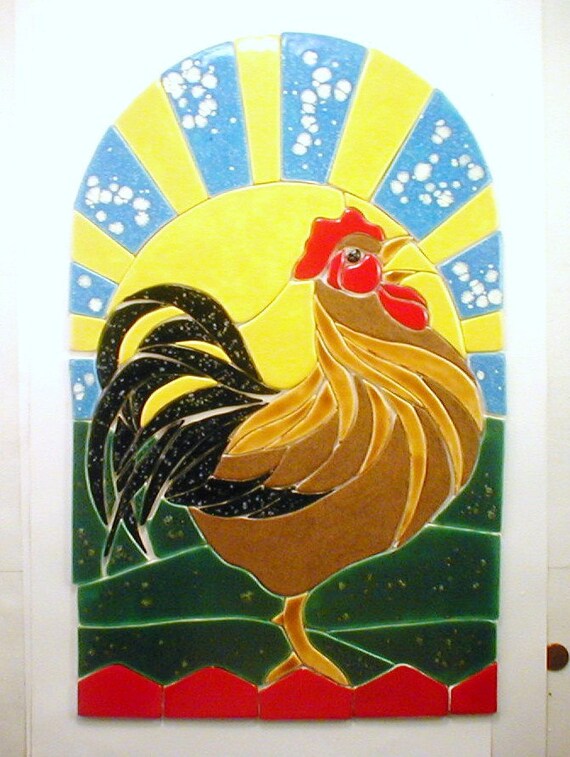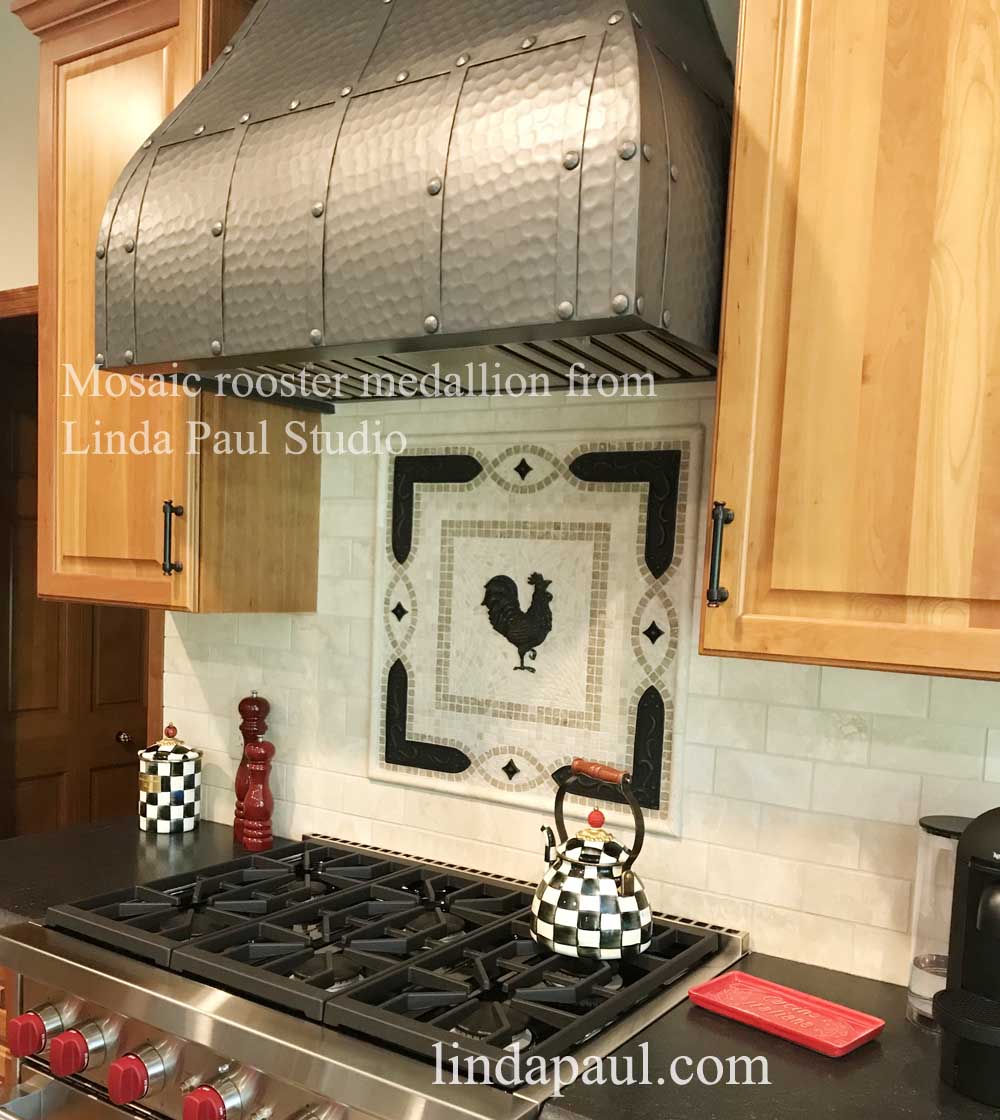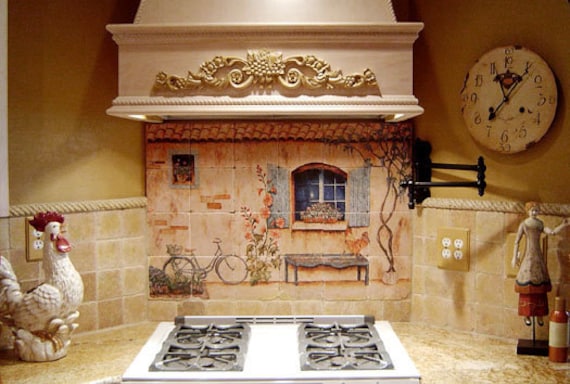Incorporating a rooster kitchen backsplash into your home can be a delightful way to add a touch of rustic charm and personality to your cooking space. Roosters have long been a symbol of farm life and country living, often associated with themes of wakefulness, energy, and even good luck. Integrating this motif into your kitchen backsplash can create a warm, inviting atmosphere that celebrates these traditional values while adding a unique decorative element to your home.
When considering a rooster-themed backsplash, it’s important to think about the overall design and color scheme of your kitchen. Rooster designs can range from simple, monochromatic silhouettes to vibrant, multi-colored illustrations. The key is to choose a style that complements your existing kitchen decor. If your kitchen has a more neutral or understated palette, a colorful rooster backsplash can serve as a focal point, injecting vibrancy and personality into the space. On the other hand, if your kitchen is already rich in color and texture, a more subtle rooster design in shades that harmonize with the rest of the room may be more appropriate.

The material of the backsplash is another critical consideration. Ceramic or porcelain tiles are popular choices for rooster-themed backsplashes because they are durable, easy to clean, and available in a wide variety of colors and finishes. Hand-painted tiles, in particular, can add an artisanal touch, giving your kitchen a custom, one-of-a-kind look. Alternatively, glass tiles can offer a sleek, modern interpretation of the rooster theme, with options for printed designs or even stained glass effects that can catch and reflect light in interesting ways. Stone tiles, such as travertine or slate, can also be used to create a more rustic, earthy feel, especially when combined with muted or natural colors.
The size and placement of the rooster backsplash should be carefully planned to maximize its impact without overwhelming the space. In many cases, the backsplash is best positioned behind the stove or sink, where it can serve as a visual centerpiece. Depending on the size of the area, you might opt for a single large rooster design, or you could create a repeating pattern of smaller roosters across the backsplash. Another option is to combine rooster tiles with other complementary elements, such as floral or vine motifs, to create a more intricate and layered design. If you have a large kitchen, a rooster backsplash could even be extended along the entire length of a wall, creating a continuous and cohesive look.

Rooster kitchen backsplashes also offer the opportunity to incorporate a variety of textures and finishes, adding depth and dimension to your kitchen. For example, a combination of matte and glossy tiles can create contrast and visual interest, while a mix of smooth and textured tiles can add tactile appeal. Raised or embossed rooster designs can further enhance the three-dimensional effect, making the backsplash a truly standout feature in the room. Additionally, using a combination of different tile shapes and sizes, such as hexagons, rectangles, or even custom-cut pieces, can contribute to a more dynamic and personalized look.
Another aspect to consider is the grout color and style. The grout can significantly influence the overall appearance of the backsplash, either by blending in with the tiles to create a seamless look or by contrasting with the tiles to highlight the design. For a more traditional or rustic feel, a darker grout can be used to emphasize the individual tiles and create a more defined pattern. Conversely, a lighter grout can help the rooster design blend more subtly into the background, creating a softer, more cohesive appearance. Some homeowners even choose to incorporate decorative grout lines or borders, adding another layer of detail to the backsplash.

Lighting is another key element that can enhance the effect of a rooster kitchen backsplash. Proper lighting can highlight the colors and details of the rooster design, making it a focal point in the kitchen. Under-cabinet lighting is particularly effective in illuminating backsplashes, providing both functional task lighting and accent lighting that draws attention to the design. Additionally, using dimmable lights can allow you to adjust the brightness according to the time of day or the mood you want to create in the kitchen. Natural light can also play a role in showcasing the backsplash, especially if your kitchen has windows that allow sunlight to filter in and interact with the tiles.
When choosing a rooster kitchen backsplash, it’s also important to think about how the design will age and whether it will remain appealing over time. While trends in kitchen design come and go, a well-executed rooster backsplash can become a timeless feature, especially if it aligns with the overall style and personality of your home. Opting for classic materials and designs, rather than overly trendy or novelty elements, can help ensure that your backsplash remains a beloved part of your kitchen for years to come. Additionally, selecting durable materials that can withstand the rigors of kitchen use, such as heat, moisture, and daily cleaning, will help preserve the appearance and longevity of the backsplash.
Rooster kitchen backsplashes can also be a way to express cultural or regional pride, particularly if the rooster has significance in your heritage or local traditions. For instance, in many cultures, the rooster is a symbol of vigilance and courage, and incorporating this motif into your kitchen can be a meaningful nod to these values. In regions with a strong agricultural or rural history, a rooster backsplash can also celebrate the connection to the land and the importance of farming and self-sufficiency. This cultural context can add an additional layer of meaning to your kitchen decor, making the rooster backsplash not just a decorative element, but also a reflection of your personal or family identity.
Installing a rooster kitchen backsplash can be a fun and rewarding DIY project for those with a passion for home improvement. Many homeowners enjoy the process of selecting and arranging the tiles themselves, creating a customized look that is truly their own. However, it’s important to approach the project with the right tools and techniques to ensure a professional-looking result. Careful planning, precise measurements, and attention to detail are key to achieving a flawless installation. For those who prefer to leave the work to the experts, hiring a professional tile installer can ensure that the backsplash is installed correctly and efficiently, with a high-quality finish that enhances the overall look of your kitchen.

Rooster kitchen backsplashes are versatile and can be adapted to suit a wide range of kitchen styles, from country and farmhouse to eclectic and even modern designs. The key is to choose a rooster design and tile material that complements the other elements in your kitchen, such as countertops, cabinetry, and flooring. For example, a rooster backsplash with earthy tones and natural textures might pair beautifully with wooden cabinets and stone countertops, creating a warm and cohesive look. Alternatively, a more colorful and whimsical rooster design could be the perfect complement to a vibrant, eclectic kitchen filled with bold colors and patterns.
Maintenance is an important consideration when choosing a rooster kitchen backsplash, especially if it is installed in a high-traffic area like behind the stove or sink. Ceramic and porcelain tiles are generally easy to clean and maintain, requiring only regular wiping with a damp cloth and mild detergent to keep them looking their best. For hand-painted or specialty tiles, it’s important to follow the manufacturer’s care instructions to avoid damaging the design. Sealing the grout is another step that can help protect the backsplash from stains and moisture, making it easier to keep clean over time. With proper care, a rooster kitchen backsplash can remain a beautiful and functional part of your kitchen for many years.
Finally, a rooster kitchen backsplash can be a great conversation starter and a way to showcase your unique style and personality. Whether you choose a bold, colorful design or a more subtle and understated look, the rooster motif can add character and charm to your kitchen, making it a space where you and your guests feel welcome and inspired. The rooster is a symbol that resonates with many people, evoking feelings of nostalgia, warmth, and connection to the simpler things in life. By incorporating this motif into your kitchen, you create a space that is not only beautiful but also meaningful and reflective of your personal tastes and values.

Common Mistakes to Avoid
One common mistake when incorporating a rooster kitchen backsplash is choosing a design that is too busy or overwhelming for the space. While it can be tempting to go all out with a vibrant, detailed rooster motif, it’s important to consider the overall balance of your kitchen design. A backsplash that is too bold can dominate the space and clash with other elements, making the kitchen feel cluttered and chaotic. To avoid this, consider the scale of the design to the size of the kitchen and choose a rooster motif that complements rather than competes with other features.
Another mistake is not considering the long-term appeal of the rooster motif. While rooster designs can be charming and whimsical, it’s important to think about whether this theme will still appeal to you in the years to come. Choosing a classic or timeless design, rather than something overly trendy or kitschy, can help ensure that your backsplash remains a beloved feature of your kitchen. Additionally, opting for high-quality materials and craftsmanship can enhance the durability and longevity of the backsplash.
Improper installation is another common pitfall. A poorly installed backsplash can result in uneven tiles, gaps in the grout, or even tiles that loosen over time. Whether you choose to tackle the installation yourself or hire a professional, it’s important to ensure that the tiles are properly aligned and securely adhered to the wall. Taking the time to properly prepare the surface and carefully plan the layout can help prevent installation issues and result in a polished, professional-looking finish.
Overlooking the importance of grout color and maintenance is another frequent error. The grout plays a crucial role in the overall appearance of the backsplash, and choosing the wrong color can detract from the beauty of the design. Additionally, failing to seal the grout can lead to stains, discoloration, and even mold growth over time. To avoid these issues, choose a grout color that complements the tiles, and be sure to apply a sealer to protect the grout from moisture and stains.
Finally, neglecting to consider the backsplash’s interaction with lighting can be a mistake. Lighting plays a significant role in how the colors and details of the backsplash are perceived, and inadequate lighting can diminish the impact of the design. Installing under-cabinet lighting or strategically placing light fixtures to highlight the backsplash can enhance its visual appeal and make the rooster motif a true focal point in the kitchen.

What materials are best for a rooster kitchen backsplash?
The best materials for a rooster kitchen backsplash are ceramic, porcelain, and glass tiles. Ceramic and porcelain tiles are durable, easy to clean, and available in a wide range of colors and finishes, making them ideal for creating detailed rooster designs. Glass tiles offer a modern, sleek option and can be customized with printed or stained glass effects. Stone tiles, such as travertine or slate, can provide a rustic, earthy feel, though they may require more maintenance. Ultimately, the choice of material depends on the desired aesthetic and the level of durability required for your kitchen.
How do I choose the right rooster design for my kitchen?
Choosing the right rooster design for your kitchen involves considering the overall style and color scheme of the space. If your kitchen is neutral or understated, a vibrant, colorful rooster design can serve as a focal point. In contrast, a more subtle rooster motif may be better suited to kitchens that already have bold colors or patterns. The scale of the design is also important; larger kitchens can accommodate bigger or more intricate rooster motifs, while smaller kitchens might benefit from a simpler or more minimal design. Additionally, consider how the rooster motif will interact with other elements in the kitchen, such as countertops, cabinetry, and lighting.
Can a rooster kitchen backsplash work in a modern kitchen?
Yes, a rooster kitchen backsplash can work in a modern kitchen, especially when executed with a contemporary twist. Opting for a sleek, minimalist rooster design, perhaps in monochromatic tones or with clean lines, can complement modern decor. Using materials like glass tiles or choosing a subtle, abstract rooster motif can also help blend the traditional rooster symbol with a modern aesthetic. The key is to balance the rustic charm of the rooster with the streamlined, uncluttered look typical of modern kitchens.

How do I maintain a rooster kitchen backsplash?
Maintaining a rooster kitchen backsplash involves regular cleaning with a soft cloth and mild detergent to remove grease, grime, and water spots. Avoid abrasive cleaners or scouring pads that can damage the tiles or grout. If your backsplash is made of ceramic or porcelain tiles, sealing the grout can help protect against stains and moisture. For hand-painted or specialty tiles, follow the manufacturer’s care instructions to preserve the design. Regularly inspect the backsplash for any signs of damage or wear and address issues promptly to keep it looking its best.
How can I incorporate a rooster motif without overwhelming my kitchen?
To incorporate a rooster motif without overwhelming your kitchen, consider using the design as an accent rather than the main feature. This could mean limiting the rooster motif to a small section of the backsplash, such as behind the stove or sink, or using it in combination with other complementary elements like floral or vine patterns. Choosing a subtle or monochromatic rooster design can also help keep the look understated. Additionally, consider balancing the rooster motif with neutral colors and simple lines in other parts of the kitchen to prevent the design from becoming too dominant.
Is it possible to DIY a rooster kitchen backsplash?
Yes, it is possible to DIY a rooster kitchen backsplash, especially if you have some experience with tile installation. The key to a successful DIY project is careful planning and attention to detail. Start by selecting the right materials and tools, and make sure to properly prepare the surface before beginning the installation. Take your time with measurements and layout to ensure the tiles are evenly spaced and aligned. If you’re unsure about any aspect of the installation, consider consulting a professional or watching instructional videos to guide you through the process. With patience and precision, a DIY rooster backsplash can be a rewarding project that adds a personal touch to your kitchen.

Rooster Backsplash murals, Rooster decor and Kitchen backsplash

Kitchen Backsplash Tiles 23.6 X 35.4 3 CHICKENS

Not-So-Common Surface Materials to Consider Copper kitchen backsplash

Related Posts:
- Backsplash Kitchen Stainless Steel
- Mediterranean Kitchen Backsplash Tile
- Kitchen Backsplash Wall Stickers
- Kitchen Backsplash Malaysia
- Ceramic Tiles For Kitchen Backsplash Pictures
- Backsplash For Grey Kitchen
- How To Install Mosaic Tile Backsplash In Kitchen
- Aqua Backsplash Kitchen
- Stone Veneer Kitchen Backsplash
- Kitchen Backsplash Travertine And Glass